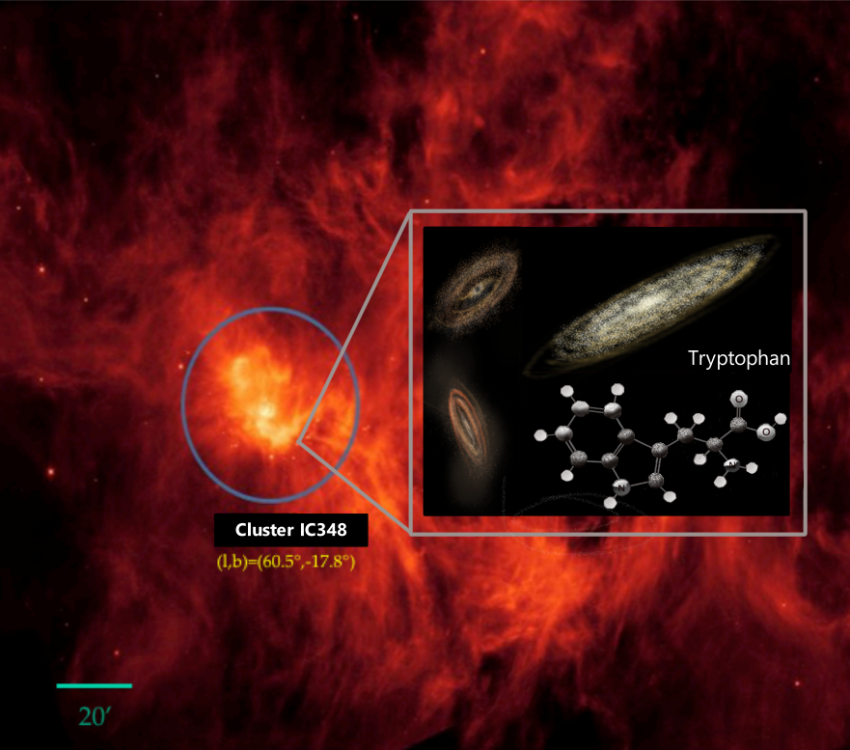Using data from the Spitzer space observatory, Dr Susana Iglesias-Groth, a researcher from The Instituto de Astrofísica de Canarias (IAC), has found evidence for the existence of the amino acid tryptophan in the interstellar material in a nearby star-forming region. The research is published in Monthly Notices of the Royal Astronomical Society.
High amounts of tryptophan were detected in the Perseus Molecular Complex, specifically in the IC348 star system, a star-forming region that lies 1000 light years away from Earth - relatively close in astronomical terms. The region is generally invisible to the naked eye, but shines brightly when viewed in infrared wavelengths.
Tryptophan is one of the 20 amino acids essential for the formation of key proteins for life on Earth, and produces one of the richest pattern of spectral lines in the infrared. It was therefore an obvious candidate to be explored using the extensive spectroscopic database of the Spitzer satellite, a space-based infrared telescope.
The analysis of the infrared light emitted from the region revealed 20 emission lines of the molecule tryptophan. The temperature of the tryptophan is about 280 Kelvin, or 7 degrees Celsius. Iglesias-Groth has previously found water and hydrogen at the same temperatures in IC348.
The study suggests that the emission lines associated with tryptophan may also be present in other star-forming regions and that their presence is common in the gas and dust from which stars and planets form.
Amino acids are commonly found in meteorites and were present during the formation of our Solar System. This new work could indicate that these protein-building agents - that are key to the development of life - exist naturally in the regions where stars and planetary systems form, and may contribute to the early chemistry of planetary systems around other stars.
Dr Iglesias-Groth says, "The evidence for tryptophan in the Perseus molecular complex should encourage additional effort to identify other amino acids in this region, and in other star-forming regions. It is a very exciting possibility that the building blocks of proteins are widely present in the gas from which stars and planets form - it may be key for the development of life in exoplanetary systems”.
Media contacts
Gurjeet Kahlon
Royal Astronomical Society
Mob: +44 (0)7802 877700
press@ras.ac.uk
Dr Robert Massey
Royal Astronomical Society
Mob: +44 (0)7802 877699
press@ras.ac.uk
Science contacts
Dr Susana Iglesias-Groth
Instituto de Astrofísica de Canarias (IAC)
susana.iglesias@iac.es
Further information
The research appears in “A search for tryptophan in the gas of the IC 348 star cluster of the Perseus molecular cloud”, Susana Iglesias-Groth, Monthly Notices of the Royal Astronomical Society, in press.
Notes for editors
The Royal Astronomical Society (RAS), founded in 1820, encourages and promotes the study of astronomy, solar-system science, geophysics and closely related branches of science. The RAS organises scientific meetings, publishes international research and review journals, recognises outstanding achievements by the award of medals and prizes, maintains an extensive library, supports education through grants and outreach activities and represents UK astronomy nationally and internationally. Its more than 4,000 members (Fellows), a third based overseas, include scientific researchers in universities, observatories and laboratories as well as historians of astronomy and others.
The RAS accepts papers for its journals based on the principle of peer review, in which fellow experts on the editorial boards accept the paper as worth considering. The Society issues press releases based on a similar principle, but the organisations and scientists concerned have overall responsibility for their content.
Keep up with the RAS on Twitter, Facebook, Instagram, LinkedIn, and YouTube.


